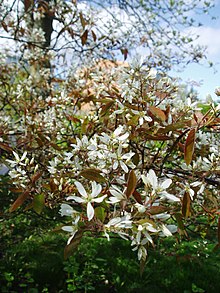| Amelanchier × lamarckii | |
|---|---|

| |

| |
| Scientific classification | |
| Kingdom: | Plantae |
| Clade: | Tracheophytes |
| Clade: | Angiosperms |
| Clade: | Eudicots |
| Clade: | Rosids |
| Order: | Rosales |
| Family: | Rosaceae |
| Genus: | Amelanchier |
| Species: | A. × lamarckii |
| Binomial name | |
| Amelanchier × lamarckii F.G.Schroed. | |
Amelanchier × lamarckii, also called juneberry, serviceberry or shadbush, is a large deciduous flowering shrub or small tree in the family Rosaceae.
Description
In spring the plant unfurls new leaves and produces star-shaped white flowers. The leaves are pink when they first open, maturing to yellow-green, and turn red in autumn. The plant's young berry-like pome fruits are dark red when young, but become dark purple when ripe.
Taxonomy
This form is a natural hybrid of A. arborea × A. laevis. (A. laevis and either A. arborea or A. canadensis); therefore under the rules of botanical nomenclature, it would be known as Amelanchier × lamarckii. The Latin specific epithet honors the French naturalist Jean-Baptiste Lamarck (1744–1829).
The European common name snowy mespilus (a name which is also attached to the related A. ovalis) reflects its close relationship with the medlar genus, Mespilus. It is also known as snowy mespil.
Distribution and habitat
The plants are originally from eastern Canada and widely naturalised in Europe. There has been some escape within North America of plants apparently secondarily derived from those European forms.
Ecology
The fruit is eaten by birds soon after it ripens.
Cultivation
The species is widely cultivated as an ornamental plant. It has gained the Royal Horticultural Society's Award of Garden Merit.
Uses
Like other species of Amelanchier, the fruits are edible with a sweet flavor.
References
- ^ "Snowy mespilus". BBC Plantfinder. Retrieved 11 September 2019.
- ^ "Amelanchier lamarckii". Royal Horticultural Society. Retrieved 30 June 2022.
- Rushforth, Keith (1999). Collins Guide to the Trees of Britain and Europe. Harper Collins. pp. 503–4.
- Harrison, Lorraine (2012). RHS Latin for Gardeners. United Kingdom: Mitchell Beazley. ISBN 978-1845337315.
- "Collins English Dictionary".
- Campbell, Christopher S.; Burgess, Michael B.; Cushman, Kevin R.; Doucette, Eric T.; Dibble, Alison C.; Frye, Christopher T. (2015), "Amelanchier Medikus, Philos. Bot. 1: 135, 155. 1789", in Brouillet, L.; Gandhi, K.; Howard, C.L.; Jeude, H.; Kiger, R.W.; Phipps, J.B.; Pryor, A.C.; Schmidt, H.H.; Strother, J.L.; Zarucchi, J.L. (eds.), Magnoliophyta: Picramniaceae to Rosaceae, Flora of North America North of Mexico, vol. 9, Oxford University Press
- "Amelanchier, A Very Tasty Wild Edible Fruit". Eat The Planet. 13 July 2013. Retrieved 30 June 2022.
External links
| Taxon identifiers | |
|---|---|
| Amelanchier lamarckii |
|
This Maleae article is a stub. You can help Misplaced Pages by expanding it. |